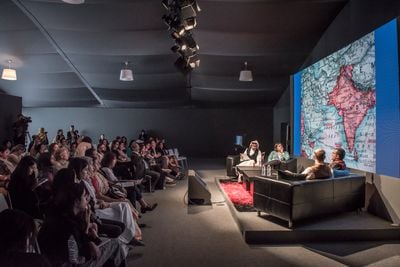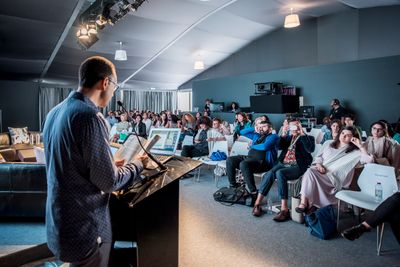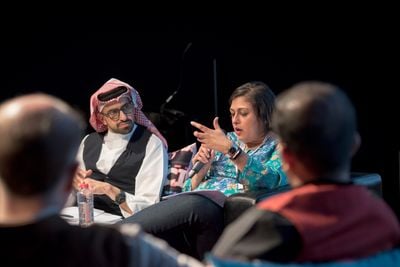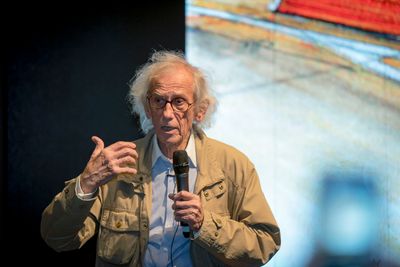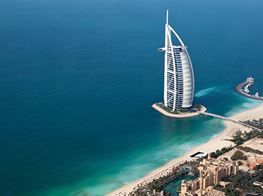Trading Places: on the 11th Global Art Forum at Art Dubai
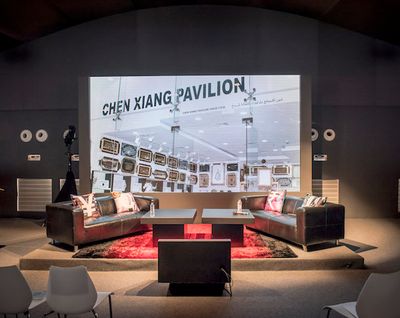
Global Art Forum 11, 'Trading Places', with an image from Farah Al Qasimi's GAF11-commissioned photographic series DRAGON! (2017), Art Dubai 2017 (21–24 March 2017). Courtesy Photo Solutions.
This year's Global Art Forum (GAF11, 15–17 March 2017) at Art Dubai invited over 25 artists, academics, and practitioners to critically address the complex architecture of trade as both a divisive and unifying site of power and exchange.
Co-directed by Antonia Carver and Oscar Guardiola-Rivera, GAF11 took its title from the 1983 film Trading Places, referencing a cinematic narrative that champions neoliberalism as a liberatory politics. Although GAF11 co-commissioner Shumon Basar mentioned this fact in passing, the title felt contextually relevant. Released during the Regan-Thatcher era, Trading Places tells the story of the Dukes brothers, two old white gatekeepers of capital brought down in the financial market by those who stand on the other side of the racial and economic line.
While the plotline of the film superficially hints at racial and economic exploitation (in as much as stereotypical performances by Dan Ackroyd and Eddie Murphy can), the promise of free-market capitalism as a site to traverse racialised capitalist society is—as the history of trade and expansionism tells us—a fiction best housed in 1980s Hollywood. Yet, to evoke this neoliberal fantasy in an art fair at a time when hardened borders and trade protectionism exacerbate deep racial and class inequality, felt like a poignant reminder of the contradictory globalised present.
Entering the Art Dubai compound made clear the extent to which the art world is implicated in this contradictory logic. As an arena of capital that relies on the participation of a global art community, the fair is unambiguously marked by its exclusions. This was clear in walking past the roped-off VIP area to the main exhibition halls, where the world's galleries, prior to the public opening, were sealed off by G4S gaffer tape that proudly professed to 'Securing the Art World'—a sign that the art market has become a securitised site of exclusionary gatekeeping, in which corporate violence is rebranded as corporate efficiency. Yet, only a short bridge walk away, the GAF11 tent offered an alternative model. While the Forum is not separate from the fair enterprise, as a discursive space that invites criticality and trans-regional perspectives, it seeks to overwrite the idea of culture as simply 'a pretext for...economic growth'. With the art market's infrastructure unambiguously on display, the fair thus becomes a touchstone for a trans-global art community to reckon with the excesses of corporatism on the art world, and the broader dynamics of trade in a global era.
The Forum's first panel 'ACC€L€RAT€!', chaired by Oscar Guardiola-Rivera, began with a short presentation by writer and editor Stephanie Bailey, who looked at the art fair-biennial exhibition model as a complex site of commodity arrangement and exchange with roots in imperialism. Offering a link between the Great Exhibition of 1851—the first World Fair—and today's biennials and art fairs, Bailey extended a historical timeline to expose the art world's complicity in the political economy of uneven development. As she stated, these spaces are bound to the unequal world-making processes wrought by globalisation and unregulated freetrade. At the same time, they are sites of trans-global exchange not only of commodities, but also of experimental ideas that, for all their contradictions, are necessary for artistic survival.
In the talk that followed, curator Mohammad Salemy reiterated the necessity for artists to access global networks in order to safeguard continued artistic work. In a political climate that is threatening artists with precarity, Salemy's intervention pointed to deep anxieties over global artistic futures, particularly those directly targeted by discriminatory policies. Joining the discussion, artist Oscar Murillo—whose live-sketches appeared on a projected screen during the talks—dismissed the political urgency of looking to the past in order to understand our present moment of chaos. This came across as a dismissive claim, which cut against the logic foregrounded in several of the Forum's talks, and sparked back-and-forth discussions. The panel did not reach a neat conclusion, but the debate offered a welcome disruption to the elite pleasure dome of Art Dubai.
In a turn away from the accelerated hyper-globality of the art world, talks by curator Omar Berrada, and academic Laleh Khalili ('DE$€RT!' and '$HIP!' respectively) looked to the boundless and de-accelerated journey of trade across the desert and the sea. For Berrada, the Sahara Desert is a site to trace Arabo-Islamic ties that stretch as far back as the 8th century between Morocco and the sub-Saharan continent—an indeterminate geography marked by the violence of the slave trade, religious pilgrimage, economic trade and cultural exchange. As Berrada noted, colonial divisions and post-colonial struggles have severed these historical and geographical ties, which have today been further exacerbated by tensions born of sub-Saharan migration to Morocco. Yet, by looking back to a time, in Berrada's words, when 'the desert acted more as a bridge than a forbidden barrier', historical trade routes offer a counterpoint to reconsider racial divisions across the continent.
For Khalili, ships are conduits to explore the sea as a palimpsest of power and history that tells of the geographies of empire; imperial hierarchies, labour dynamics, and hidden infrastructures in the service of militarisation and economic organisation. Offering as much of a logistics as a literary tour, which ranged from Melville and Marx to Walter Benjamin, who described the voyage of the sea as 'modernised music of the world', Khalili warned that this utopic view, 'belies the production of difference on board ships'. For as much as the sea invites poetic contemplation, it continues to be the source of divisive labour politics and neo-colonial dynamics. By exposing the infrastructures of trade, Khalili then pointed to the significance of rethinking how the present moment becomes a way to understand past dynamics of struggle and progress. Ending her talk, she remarked: 'These awesome spectacles—the ships and the ports—demand of us attentiveness to history and geography.'
It was precisely this concern with history as a ballast to understand our indeterminate political present that informed William Dalrymple's talk on the East India Company. As a heavily militarised multinational—which he likened to 'Facebook with fighter-jets'—the Company's history shows how corporatism is not a new epoch of capital, but a legacy of imperial expansion. Dalrymple also showed how legacies of imperial carelessness have resulted in a prolific art looting economy. As a Hindustani term that emerged in late 18th century Britain, the history of looting has contributed to the growth of global art economies today. In his own talk, Mohammad Salemy likened the free-ports of the UAE to the unregulated political economy of art, making reference to the UAE port's role in the circulation of looted antiques from Syria. This point further reiterated the violence of trade as a neo-colonial enterprise, and Dubai's central position within these dynamics.
The history of Dubai's controversial informal economies was further tackled in 'GOLD!', an enlivened panel with speakers James Olney, Dr. N. Janardhan and Neha Vora led by Sultan Sooud Al-Qassemi. Speaking about historical trade links between Dubai and Mumbai through the informal network of gold smuggling, the discussion wove humorous personal anecdotes with larger historical shifts to elucidate the reciprocal dynamics of trade, not simply as commodity exchange, but as cultural and linguistic exchange. Touching on Dubai's pre-oil economic reliance on the Indian economy, the panel highlighted just how much the power dynamics between India and the UAE have shifted. By reflecting on a bygone trade history rather than on the futurity of Dubai, an alternative narrative of the Emirate emerged: one that offered an ancestral backbone to the corporate façade so clearly on display here.
This creation of alternative albeit material narratives continued in a series of talks commissioned for GAF11 titled '$OLD! PACK! $€ND!', which mapped an alternative geography of trade through the lens of a given art work. For Kristine Khouri, a painting titled Géométrie Palestinienne (Palestinian Geometry) (1977) by Moroccan artist Mohammed Chabba, mapped a trans-regional art history that stretched from Morocco to Iran. Produced for the Palestinian Liberation Organisation's seed collection for the Museum of Palestine, Chabba's painting was shown in a 1978 exhibition hosted in the basement of the Beirut Arab University. However, the larger museum project was never realised, due to the destruction of several works in the collection by Israel's attack on Lebanon in 1982, and ongoing colonial realities in Palestine. Charting the work's travels, both physically—through institutions and trans-regional exhibition networks—and the discourse the painting generated, Khouri's talk traced the continuities and ruptures of pan-Arab art histories, focusing on a time when art was foregrounded as a network of shared intimacies.
At the final talk by the renowned artist Christo, intimacy was considered on a somewhat monumental register, drawing the largest GAF11 audience and staged as a direct Q&A between artist and audience. As Christo discussed his large-scale projects, it became clear that their public impact was only made possible through a vital relationship with his now deceased lover and collaborator Jean-Claude. The focus on biographical detail was an important political reminder of building intimacies at a time of great uncertainty.
The three-day Forum closed with a screening of Ron Fricke's non-narrative documentary Samsara (2011), which translates as 'wandering' or 'world' in Sanskrit. Curated by Cinema Akil, whose aim is to cultivate an art cinema culture in Dubai, the choice felt somewhat misguided. On screen, a montage of highly saturated images from over 25 countries across the globe are carried over by a 'world-music' soundtrack, amounting to nothing more than a geographical accumulation of voyeuristic intrigue in disaster zones and orientalising imagery from the Global South: a visual reminder of the dangers wrought by cultural reductionism that subsumes cultural difference into a totalising aesthetic regime (presumably for art-house kudos). I was here reminded of Bailey's earlier quoting of Paul Young, who in speaking of the Great Exhibition argued: 'What occurred here, was a pronounced exhibitionary drive to strip knowledge of non-European communities of cultural and historical significance in order that they might be easily assimilated and profitably assimilated into a global economy'.
To end on a film that jarred with an otherwise nuanced and engaging forum on cultural complexity felt like a rupture: one that warned of the pitfalls of global aesthetic production. If Samsara stands at one end of the spectrum of our commodified and globalising cultural present, the Forum's ambitious programme stands at the other. As Payam Sharifi of Slavs and Tatars argued during a panel on invisible infrastructures, art, at its most effective, opens up a 'zone of indeterminacy' to consider ways of thinking beyond monetised logics, political agendas or restrictive methodologies. By moving beyond the concerns of the art world to consider history, politics, and storytelling, this year's discussions succeeded in opening new navigational pathways to think through the present moment.—[O]

